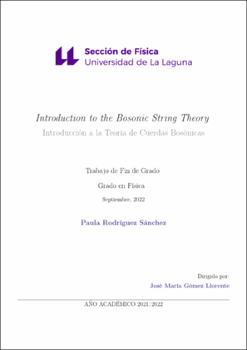Introduction to the Bosonic String Theory
Autor
Rodríguez Sánchez, PaulaFecha
2022Resumen
In this work we analyze the main aspects related to the appearance and development of bosonic
string theory from an introductory point of view and with the knowledge obtained during the degree.
First, we present the tools that modern physics uses to solve problems, the Principle of least action,
and we work on some examples such as the action of the free particle with the aim of establishing
the knowledge for the resolution of the movement of the relativistic particle, and study later the
movement of the relativistic string. We carry out a brief review of the events that gave rise to
this theory of bosonic strings as well as other theories that emerged with the aim of unifying the
four forces: the gravity force, the electromagnetic force, the weak force and the strong force. We
continue the study looking for symmetries and conserved quantities that will significantly reduce the
complexity of the problem at hand. We carry out two types of quantization in our theory: canonical
and light cone quantization, and we obtain the mass spectrum for bosonic strings. Finally, we discuss
the current situation of string theory, the problems it has solved and the ones it intends to solve in
the future. En la presente memoria analizamos los principales aspectos relacionados con la aparición y desarrollo de la teoría de cuerdas bosónicas desde un punto de vista introductorio y con los conocimientos
obtenidos durante el grado. Primero presentaremos las herramientas que utiliza la física moderna para la resolución de problemas, el Principio de mínima acción, y trabajaremos algunos ejemplos como
el de la acción de la partícula libre con el objetivo de asentar los conocimientos para la resolución
del movimiento de la partícula relativista, para posteriormente, estudiar el movimiento de la cuerda relativista. Llevaremos a cabo un breve repaso por los acontecimientos que dieron lugar a esta
teoría de cuerdas bosónicas así como otras teorías que surgieron con el objetivo de unificar las cuatro fuerzas: la fuerza de la gravedad, la fuerza electromagnética, la fuerza débil y la fuerza fuerte.
Continuamos el estudio buscando simetrías y cantidades conservadas que reducirán notablemente la
complejidad del problema que nos ocupa. Llevaremos a cabo dos tipos de cuantización en nuestra
teoría: la cuantización canónica y la del cono de luz, obtendremos el espectro de masas para cuerdas
bosónicas. Finalmente, discutimos la situación de la teoría de cuerdas actualmente, los problemas
que ha resuelto y los que pretende resolver en el futuro.





